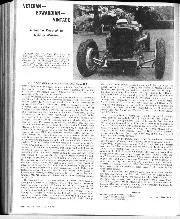
Veteran-Edwardian-vintage, August 1971
A section devoted to old-car matters The VSCC Oulton Park Meeting Held too late for a report to appear in the July Motor Sport, this was far too good a…
THE NEXT RAG. RALLY BLACKPOOL THE VENUE
THE 1938 R.A.0 Rally will be the seventh of the series and Blackpool has been chosen as the venue. Blackpool has much to commend it and it certainly knows how to entertain competitors and. has had previous experience of rallies, though, as a young lady enthusiast whom we met at Southport reminded us, you can soon have too much of the famous Lancashire seaside town. As before there will be a road section of 1,000 miles and there will be five starting places, provisionally selected as London, Leamington, Stirling, Harrogate, and Torquay. One very good point is that stiffer routes will be used ; previously the Welsh itinerary alone has presented a reasonable mileage of tough going. Against this, however, there is to be a compulsory stop on the second night, so that competitors will be on the road very little longer at a stretch than is the case in M.C.C. trials—i.e., noon Tuesday until Wednesday night—which detracts considerably from the adventure-aspect, for, in the past, whatever was said beforehand, when starting time arrived there was something enthralling about two nights and almost two days on the road. The new rule may be wise from the safety viewpoint although, as the time spent behind the wheel by any one driver was already limited, it should not have been necessary. Perhaps widespread disregard for this driving-period ruling in the past has made the new arrangement desirable, but unkind people will undoubtedly point out that the Wednesday night’s stop will cost money and perhaps give rise to more smashed hotel fittings and furniture than before. We imagine that cars will be under official observation during this enforced stop. The 1938 Rally, therefore, comprises a run about as strenuous as an M.C.C. trial (for most competitors in these trials remain up all the preceding afternoon, even if
not driving their cars) followed by a 200 mile drive on the Thursday to Blackpool. On arrival there will be a test of acceleration and braking and as this is announced as primarily a test of cars we hope the distances between obstacles, or the timed sections, will be of reasonable length. Further, secret tests will be held on the Friday and, here again, we hope they will be either driving-tests or car-performance tests and not a confused mixture of both. We had some observation on this aspect of the Rally in our report of the last R.A.C. event at Hastings in the issue for April, 1937. The Coachwork Competition will be under amended ruling, in conjunction with the S.M.M.T. Regulations were issued last month. The Rally classes are : up to 10 h.p. open ; up to 10 h.p. closed ; 10 to 15 h.p. open ; 10 to 15 h.p. closed ; over 15 h.p. open and over 15 h.p. Closed. We have always believed that there is a definite place in the scheme of things for the Rally and that it constitutes worth-while adventure and would, given sensible concluding tests, be quite a good means of car-judging. Actually, were we drawing up the conditions we should dispatch competitors on the Tuesday morning and send them via the most difficult possible routes to a private drive where all would be timed over a standing quarter-mile and then dispatched on their night drive over different routes to a common bit of hilly country where, on the Wednesday morning, a clean climb of one stiff gradient and a clean restart on another would be required. They would then go on a common route to Brooklands for a speed and second acceleration test on the Wednesday evening, running through the night and following morning to a concluding venue in difficult approaching country sonic 250 miles distant. On arrival cars would be parked under official control and, without attention, would be asked to do easy starting, slow-running and, to amuse those who are experts at throwing motors around, a driving test, all on the Friday. But the last named would involve reaching speeds up to 70 m.p.h., to show up weaknesses in brakes, steering and transmission, etc. We should not worry about dented wings. However, one can hardly expect the R.A.C. to do all that, and we hope the 1938 Rally, as they present it, will attract excellent entries. We believe that certain trials enthusiasts had thought of approaching the R.A.C. and suggesting a three days’ trial in the Highlands to replace the 1938 Rally, the idea being that many prospective entrants could not afford the time and/or expense of competing in two events a year, entailing five days away from business or home. We like the idea of a big Scottish multi-day trial but it has to be remembered that the Rally attracts a considerable number of non-trials folk every year, and that the R.A.C. puts it on for its touring and social, as
well as for its competitive, appeal. A trial should not be allowed to replace it. The date of the 1938 Rally is April 20th30th.
It appears that the scheduh . for the first part of the Rally will be in the neighbourhood of ’25 to 27 m.p.h., but that that for the final 200 miles may be stiffer. It will be interesting to see whether the Wednesday’s night halt is at a communal centre, or separate for each starting point. If the former, accommodation in one town will have to be found for some 500 persons, if entries are up to this year’s standard, and there will be the additional disadvantage that a very large number of cars will be running over the same route of 200 miles to the finish. In the last R.A.C. Rally 192 cars started and 184 finished the road-section.